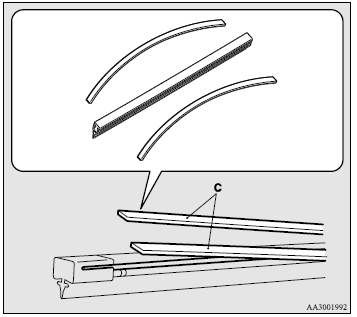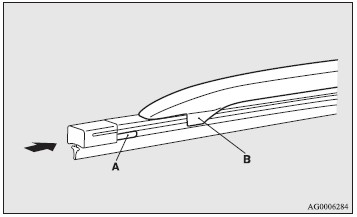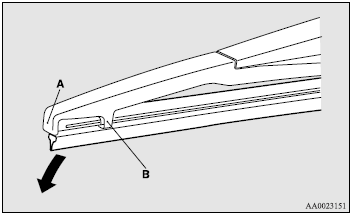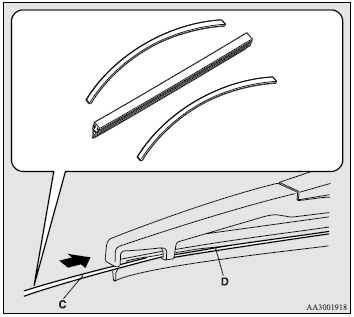Mitsubishi Outlander: Wiper blade rubber replacement
Windscreen wiper blades

1. Lift the wiper arm off the windscreen. 2. Pull the wiper blade until its stopper (A) disengages from the hook (B). Pull the wiper blade further to remove it.
NOTE:
● Do not let the wiper arm drop onto the windscreen. This could damage the glass.
3. Attach the retainers (C) to a new wiper blade. Refer to the illustration to ensure that the retainers are correctly aligned as you attach them.

4. Insert the wiper blade into the arm, starting with the opposite end of the blade from the stopper. Make sure the hook (B) is fitted correctly in the grooves in the blade.
NOTE:
● If a retainer is not supplied with the new wiper blade, use the retainer from
the old blade.

5. Push the wiper blade until the hook (B) engages securely with the stopper (A).
Rear window wiper blades

1. Lift the wiper arm off the window glass. 2. Pull the wiper blade downward to disengage it from the stopper (A) at the end of the wiper arm. Pull the wiper blade further to remove it. 3. Slide a new wiper blade through the hook (B) on the wiper arm.
NOTE:
● Do not allow the wiper arm to fall onto the windows glass; it could damage the
glass.

4. Firmly insert the retainer (C) into the groove (D) in the wiper blade. Refer to the illustration to ensure that the retainers are correctly aligned as you insert them into the groove.
NOTE:
● If a retainer is not supplied with the new wiper blade, use the retainer from
the old blade.
General maintenance
Fuel, engine coolant, oil and exhaust gas leakage
Look under the body of your vehicle to check for fuel, engine coolant, oil and exhaust gas leaks.
WARNING:
● If you see a suspicious fuel leak or if you smell fuel, do not operate the vehicle;
call your MITSUBISHI MOTORS Authorised Service Point for assistance.
Exterior and interior lamp operation
Operate the combination lamp switch to check that all lamps are functioning properly. If the lamps do not illuminate, the probable cause is a blown fuse or defective lamp bulb. Check the fuses first. If there is no blown fuse, check the lamp bulbs. For information regarding the inspection and replacement of the fuses and the bulbs, refer to “Fuses” on page 8-23 and “Replacement of lamp bulbs” on page 8-35. If the fuses and bulbs are all OK, we recommend you to have your vehicle checked and repaired.
Meter, gauge and indicator/warning lamps operation
Start the engine and check the operation of all instruments, gauges and indicator and warning lamps. If there is anything wrong, we recommend you to have your vehicle inspected.
Hinges and latches lubrication
Check all latches and hinges, and, if necessary, have them lubricated.
For cold and snow weather
Ventilation slots
The ventilation slots in front of the windscreen should be brushed clear after heavy snowfall so that the operation of the heating and ventilation systems will not be impaired.
Weatherstripping
To prevent freezing of the weatherstripping on the doors, bonnet, etc., they should be treated with silicone grease.
Additional equipment
It is a good idea to carry a shovel or a short-handled spade in the vehicle during the winter so that you can clear away snow if you get stranded. A small hand-brush for sweeping snow off the vehicle and a plastic scraper for the windscreen and rear window are also useful.
Fusible links
The fusible links will melt to prevent a fire if a large current attempts to flow through certain electrical systems. In case of a melted fuse link, we recommend you to have your vehicle inspected. For the fusible links, please refer to “Fuse load capacity” on page 8-29.
WARNING:
● Fusible links must not be replaced by any other device. Failing to fit the correct
fusible link may result in fire in the vehicle, property destruction and serious
or fatal injuries at any time.
See also:
If the Engine Overheats
The engine could overheat temporarily under severe driving conditions. If the
engine coolant temperature gauge indicates overheating during driving: 1) Turn off
the air conditioner, if equipped. 2) Take the vehicle to a safe place and park.
3) ...
New vehicle break-in driving – the first 1,000 miles (1,600 km)
The performance and long life of your
vehicle are dependent on how you handle
and care for your vehicle while it is new.
Follow these instructions during the first
1,000 miles (1,600 km):
- Do not race the engine. And do not
allow engine s ...

 Tyres
Tyres